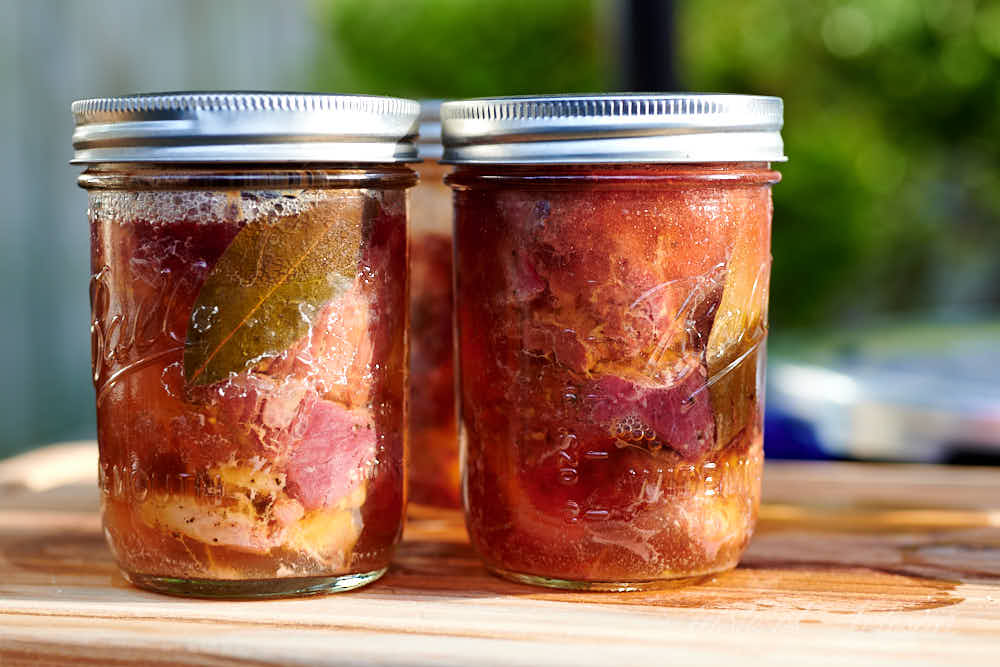Have you ever tried canning meat? It takes being confident enough to let it sit on a shelf without refrigeration and trusting that it will be ok to eat.
This was one of the hardest things to can for me (not hard to do, just the thought of it), but I wanted to try canned meat and see how it really held up. I was very pleasantly surprised at the outcome and it was actually really good.
Basic Canned meat (for beef) directions:
- place jars in warm canning water to keep warm
- cut off fat and cube the meat into 1-inch squares
- heat water to boiling in a kettle or pan that you can pour from
- fill the jars by raw packing in the meat
- add 3 inches of boiling water
- add lids and tighten finger tight
- place in a pressure canner, cover, let vent for 10 minutes
- after 10 minutes, add jiggler or weight and bring to 10 or 15 depending on altitude
- process in a pressure canner for 90 minutes
- let vent and sit out on towel until cooled for 24 hours
You’ll need:
- Pressure canner
- Pint jars or Quart Jars
- Canning lids and bands (new lids for each jar, bands can be reused)
- Canning tools: jar lifter, canning ladle, funnel, and bubble popper
- Plus basic kitchen supplies such as a large saucepan, large prep bowl, liquid measuring cup, kitchen towels, tongs, mandoline, or knife and a cutting board.
Ingredients
- stew meat, roast meat or round steak cubed
- bay leaf
- 1 tsp salt per quart jar
- any other seasonings you’d like to flavor your meat with
Canned Meat Canning Steps
Step 1: Prepare the equipment
- put water into canner for the water bath
- place jars in warming pressure canner
- heat on medium-high heat to keep jars warm until ready to fill
- heat water to boiling in kettle or pan that you can pour from
Step 2: Cut the meat
- cut off fat and cube the meat into 1 inch squares
- fill the jars by raw packing in the meat
Step 3: Canning the meat
- add 3 inches of boiling water
- add lids and tighten finger tight
- place in a pressure canner, cover, let vent for 10 minutes
- after 10 minutes, add jiggler or weight and bring to 10 or 15 depending on altitude
- process in a pressure canner for 90 minutes
- let vent and sit out on towel until cooled for 24 hours
Popular canned meat questions:
What is the best cut of beef for canning?
Can roast beef be canned?
Can raw meat be canned?
Can you can frozen meat?
Does canned meat have to be covered in liquid?
How long will canned beef last?
What is the longest-lasting canned food?
What food never expires?
- Baking soda: lasts indefinitely, though it can lose its leavening power over time. To test, combine 2 tsp vinegar and ¼ tsp baking soda. If it bubbles, you’re good to go.
- Beans and legumes (dried, in general). Note: the older the beans, the longer they’ll need to soak and cook. Including:
- Black beans
- Black-eyed peas
- Cannellini beans (white kidney beans)
- Garbanzo beans (chickpeas)
- Great Northern beans
- Kidney beans
- Lentils
- Lima beans
- Navy beans
- Pinto beans
- Soybeans
- Split peas (dried)
- Corn syrup
- Hard liquor: Exception: cream liqueurs – because of the dairy, heed the label regarding “use by” dates.
- Honey (raw): Natural sugar, high acidity and low moisture ensures this liquid gold lasts forever (archeologists have even unearthed edible honey in ancient Egyptian tombs). But it can crystallize over time. No worries – just set the jar in a pan of warm water to liquify.
- Maple syrup (pure)
- Salt: non-iodized salt (like natural sea salt) lasts forever. But even iodized table salt has a pretty long shelf life – five years.
- Spices (dried): They will lose their aroma and flavor over time but are safe to eat indefinitely.
- Sugar, including
- Granulated sugar
- Powdered sugar
- Brown sugar
- Vinegar, including:
- Apple cider vinegar
- Balsamic vinegar
- Distilled vinegar
- Red wine vinegar
- Rice vinegar (unseasoned)
- White wine vinegar
- Vanilla extract (pure)
- White rice
Read the full article from Parade – 100+ Foods That Never Expire (Or at Least Not for a Very Long Time)
Items mentioned in this article:
*We sometimes use affiliate links on our site for items that I use, recommend, and love. The links are free for you to use and it helps support my site by providing a commission for the recommendation. I greatly appreciate you clicking on any recommended links I provide.*
You Might Also Like
Create and Organize a Homeowners Binder – Tracking and Checklists

Pescatarian vs Flexitarian – What’s the Difference?

Best Dog Toys, Dog Treats, Snuffle Mats & Dog Puzzles


